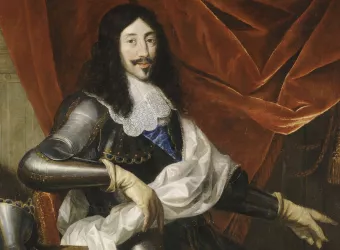The establishment of the Court and the seat of power in Versailles had been underway since 1677, when the works on the site were sped up and the king doubled up state services between Paris and Versailles. On 6 May 1682, Versailles became the headquarters of the government. Athough Paris never ceased to be the official capital, the decision made Versailles the de facto centre of the kingdom until 1789. Above all, and to the great dismay of Colbert, who wanted the king and his court to stay in Paris, the move confirmed to the king just how much he liked Versailles. The works on Versailles were only just beginning.

Versailles, “capital” of the kingdom, 1682 6 May 1682
In 1682 the Marquis de Sourches, talking of Versailles, remembered that “he loved this residence with a passion beyond reason”. His listener, King Louis XIV, already disliked Paris; he had been afraid of the city since he was a boy, when he had been forced to leave in some haste in 1649 to escape the Fronde (a series of French civil wars between 1648 and 1653).
Despite Colbert’s best efforts in renovating the Louvre and the Tuileries, the king felt at ease only in Versailles. The sovereign was a man of the open air, with a strong interest in architecture and construction. In Versailles, unrestrained by noteworthy architecture (except for the small village, which he demolished) he was able to give free rein to his love of buildings. The location perfectly suited his ambitions. As well as a vast palace and splendid gardens, he was able to construct a modern town with large, wide open roads that was completely the opposite to Paris, which was dirty, had small, narrow streets, and was crammed within its defensive walls. The king's mind was made up. Probably around 1678, he began to plan to move the government to Versailles.
ANECDOTE
Between 1678 and 1682, Louis XIV built more than in his previous 20 years on the throne!
The king was 40 at the time and at the height of his power: he was on the point of signing the Peace treaties of Nijmegen with Holland. Between 1678 and 1682, Louis XIV built more than in his previous 20 years on the throne. To accommodate the government and his family, he tasked Hardouin-Mansart with linking the four pavilions of the Secretaries of State to create the Ministers’ Wings (1678-79) and building the South Wing (1679-82), which entailed building the Orangery at the end to support it. He also had the Marble Courtyard modified, to blend it into the rising Hall of Mirrors (1678-1686). It was also at this time that he had the Lake of the Swiss Guard dug out and built a large vegetable garden nearby, which he entrusted to La Quintinie (1677-1683).
The works were driven forward at full speed, and in 1679 Mansart began the construction of the Great and Small Stables. In 1680 Le Nôtre set out to reorganise the Grande Perspective in the gardens by drawing up the Great Lawn, and the Grand Commun was built in 1682-1684 to house the king’s servants. But Louis XIV had broader ambitions. He decided to build a new Superintendance for Buildings in 1683, a North Wing in 1685 to accommodate the Court, and a new chapel (1699-1710). In 1685 over 36,000 workers were labouring on the various Versailles projects and annexes. A considerable amount of money was spent, leading to the creation of the Versailles that we know today. Such were the consequences of 1682.












